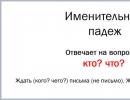System for transferring primary USE scores. Transfer of Unified State Exam points: Detailed description of the assessment system
Grading system for the Unified State Examination in mathematics profile level much more difficult. Firstly, exam tasks have different “prices”. The tasks from the first part (with a short answer) are the cheapest; the most “expensive” are the last two problems (an equation or inequality with a parameter and a problem in number theory).
In 2016, the ideal solution to all nineteen tasks can bring 32 primary scores. Maximum amount points decreased by two compared to 2015, since the first part now offers not 14, but 12 tasks.
Primary scores are converted to test scores. The conversion scale varies slightly from year to year. Below is the table that was used at the Unified State Examination in mathematics in 2015. Note that the corresponding function is very different from linear: fast growth in the area of low estimates it gives way to a smoother one in the middle of the scale.
Unified State Examination in mathematics (profile level). Scale for converting primary scores into test scores
| Primary score | Test score |
| 0 | 0 |
| 1 | 5 |
| 2 | 9 |
| 3 | 14 |
| 4 | 18 |
| 5 | 23 |
| 6 | 27 |
| 7 | 33 |
| 8 | 39 |
| 9 | 45 |
| 10 | 50 |
| 11 | 55 |
| 12 | 59 |
| 13 | 64 |
| 14 | 68 |
| 15 | 70 |
| 16 | 72 |
| 17 | 74 |
| 18 | 76 |
| 19 | 78 |
| 20 | 80 |
| 21 | 82 |
| 22 | 84 |
| 23 | 86 |
| 24 | 88 |
| 25 | 90 |
| 26 | 92 |
| 27 | 94 |
| 28 | 96 |
| 29 | 97 |
| 30 | 98 |
| 31 | 99 |
| 32 | 100 |
| 33 | 100 |
| 34 | 100 |
To enter a university you must earn a minimum 27 points(i.e., solve 6 simple tasks from the first part). Naturally, admission to serious educational establishments requires significantly higher results.
I would like to emphasize once again: the table above is just a guide! When assigning a test score, not only the number of primary points, but also the relative complexity of the problems solved, as well as the number of schoolchildren who completed a particular task. Thus, the final “formula” for transferring points will be known only after passing the Unified State Exam- 2016 in mathematics by all graduates.
The video course “Get an A” includes all the topics necessary to successfully pass the Unified State Exam in mathematics with 60-65 points. Completely all tasks 1-13 of the Profile Unified State Exam in mathematics. Also suitable for passing the Basic Unified State Examination in mathematics. If you want to pass the Unified State Exam with 90-100 points, you need to solve part 1 in 30 minutes and without mistakes!
Preparation course for the Unified State Exam for grades 10-11, as well as for teachers. Everything you need to solve Part 1 of the Unified State Exam in mathematics (the first 12 problems) and Problem 13 (trigonometry). And this is more than 70 points on the Unified State Exam, and neither a 100-point student nor a humanities student can do without them.
All the necessary theory. Quick ways solutions, pitfalls and secrets of the Unified State Exam. All current tasks of part 1 from the FIPI Task Bank have been analyzed. The course fully complies with the requirements of the Unified State Exam 2018.
The course contains 5 large topics, 2.5 hours each. Each topic is given from scratch, simply and clearly.
Hundreds of Unified State Exam tasks. Word problems and probability theory. Simple and easy to remember algorithms for solving problems. Geometry. Theory, reference material, analysis of all types of Unified State Examination tasks. Stereometry. Tricky solutions, useful cheat sheets, development of spatial imagination. Trigonometry from scratch to problem 13. Understanding instead of cramming. Clear explanations of complex concepts. Algebra. Roots, powers and logarithms, function and derivative. A basis for solving complex problems of Part 2 of the Unified State Exam.
The transfer of Unified State Examination points is made after the primary result is calculated; based on the approved scale, it is converted into test scores.
They are playing important role upon admission to a university and are recorded in the exam certificate.
Those who are finishing 11th grade and preparing to enter a university are especially interested in learning how the transfer is carried out score Unified State Exam.
Hundreds of thousands of students undergo this procedure every year. To obtain a certificate, it is enough to pass only two subjects - mathematics and Russian language.
The remaining subjects - and there are 14 in total - are taken on a voluntary basis, depending on the chosen university.
In order for the results to be displayed in the certificate, the graduate must score more than the established minimum.
How are the Unified State Exam results assessed?
The exam results are assessed by a commission and translated into a 100-point system.
There is an algorithm for converting these amounts into more familiar estimates. This method has not been officially used since 2009.
But if you wish, you can familiarize yourself with the scale for converting Unified State Examination grades.
The results are assessed in two stages:
- Based on the number of tasks completed, the student is given a primary score. It consists of the sum for all tasks completed correctly;
- Next, the primary Unified State Exam scores are converted to test scores. This figure is recorded in the Unified State Examination certificate and plays an important role for admission to a university. Below is a translation table for the math exam.

Important: The scale was developed taking into account the complexity of the tasks.
Up-to-date information on the Unified State Exam can always be obtained on the portal http://ege.edu.ru/ru.
What is the minimum score?
To receive a Unified State Exam certificate, a student must score above the established minimum limit in Russian language and mathematics.
It is determined annually for each individual subject. In fact, the minimum grade is the equivalent of a C.
This result reflects that the student has satisfactorily mastered the curriculum.
Minimum score:
- Determines the issuance of a certificate of passing the Unified State Exam.
- It is established for each subject annually after passing the exam and before the results are published.
At the end of 2016, to obtain a certificate it was necessary to obtain at least 36 test points in the Russian language.
In mathematics this limit is 3, and in the specialized level - 27.
The difference between primary scores and test scores
When assessing the results of passing the exam, the primary amount is first set. Then these USE 2017 scores are converted into test scores.
They are determined on a 100-point scale. This score will appear on the Unified State Examination certificate if it is higher than the minimum.
When calculating points, the algorithm is as follows:
- For each correctly completed task, one or more points are awarded.
- At the end, the amount for all the work is calculated.
- The primary Unified State Exam scores are being translated.
Regarding test scores, they are calculated on a 100-point system. But the amount of primary may differ for different items.
For example, in mathematics you can get 30 primary points, and for foreign languages this limit is 80.
The assessment of the task depends on its complexity. For tasks in Part B, one primary point is awarded for the correct answer.
For part C, there are several options: for tasks 1 and 2, 2 primary points are awarded; the correct answer to question 3 and 4 immediately gives 3, and tasks 5 and 6 will add 4 points to the student’s result.
Unified State Exam scores and grades
Although there is an approximate scale for converting Unified State Exam points into grades that are familiar to all students, starting from 2009 this system has not been used.

The refusal to convert to grades is due to the fact that the sum of points does not affect the indicator in the certificate. It is recorded in a separate certificate.
If a student scores less than the minimum in one of the required subjects, he will not be issued a certificate or certificate.
If this is a subject that is taken on a voluntary basis, the result simply will not be counted anywhere.
If the exam results result in an unsatisfactory grade, what should I do? It all depends on what subject.
- If the number of points scored is below the minimum in mathematics or in the Russian language, you can retake the exam in the same year on one of the reserve days.
- When an unsatisfactory grade is received in both subjects at once, a retake is possible only the next year.
- If you fail to score enough points in an optional subject, you can only retake the exam next year. An unsatisfactory result will not be reflected in any document. In fact, everything will look as if the graduate did not take this exam at all.
Depending on the subject, retaking is possible either in the same year on reserve days or in the next year.
Thus, if a student fails Basic Level Mathematics, he or she can take advantage of reserve days.
And if a low grade was obtained based on the results of a profile level, a retake will be possible only after a year.
What to do if a graduate does not agree with the assessment
If a graduate is confident that his work deserves a higher grade, he has the right to appeal.
In such a situation, the work will be reconsidered by the conflict commission.
There are two possible outcomes. When a grade appears to be too low, the student can either have points added or deducted.
Important: According to the results of the Unified State Examination in 2010, of all the appeals filed, the third part was satisfied.
The first two parts of the exam are tested without human intervention. The possibility of errors cannot be ruled out.
This may be due to illegible handwriting and similar circumstances.
If it appears that the grade is too low, students will appeal.
What does the exam consist of?
The general text of the task consists of three parts.
- Part A is designed as a test. Of the four proposed answer options, the graduate must choose one correct one.
- In Part B, the following types of tasks are possible: writing a one-word answer, choosing several correct options, or establishing correspondences.
- In Part C, the student is asked to give a detailed answer to the question.
Depending on the type of task, the verification process differs. The first two parts are checked automatically. Answers are scanned by the system and scored.
This process takes place without human intervention. Upon completion of the test, the results are sent to the testing center located in Moscow.
Part C is assessed by two independent experts. If the results coincide, this total is displayed.
If a minor discrepancy is found after evaluation, the average result is displayed.
If there is noticeable inconsistency, a third specialist is appointed.
After the verification is completed, all data is sent to a single testing center. There they are processed and recorded in the database.
From there they are sent to schools where the exam was held.
How Unified State Exam results affect university admission
In order to apply for admission to a university, graduates need to pass the Unified State Exam.
In total, you can apply to 5 universities, in each of them no more than three specialties.
The application is prepared in writing and delivered in person or sent by mail.
If the second option is chosen, you will need to issue a registered letter with a list of the attachments, as well as a receipt.
To find out whether the application was approved, you need to go to the official website of the university.
When the acceptance of documents is completed, a list of those applying for enrollment is posted there. Their results of passing the Unified State Exam are also given there.
Enrollment takes place in two waves.
- When the first list is published, several days are allotted for applicants to provide the originals of their documents (in most cases they send copies).
- If the deadline for submitting documents has expired, but there are still free places, a second list is prepared.
To enroll in a university, you will need the following package of documents:
- application requesting admission;
- certified copies of the certificate and identity document;
- a form with a list of points scored based on the Unified State Examination results;
- photographs (their size and number are established by the university rules).
Other documents may also be required from the applicant. For detailed information, please contact the university of interest.
The transfer of Unified State Exam points in 2017 is carried out according to the same system as in previous years.
To pass the exam you need to score at least minimal amount points, which is set for each subject annually.
To obtain a certificate and Unified State Exam results, you need to exceed this limit in compulsory subjects.
How to convert primary scores into test USE 2015 in Russian language
IMHO, in mathematics it’s something like this. I would say from 75 (according to previous years, I haven’t looked at the ratio of “solved problems - Unified State Examination points"). 100 points is very good knowledge+ a little luck + psychological stability.
Added after 6 minutes 27 seconds:
There is a free tutor - Internet, books, etc. But... you have to plow, plow yourself without reminders and control. And another question: in what years is a person from an ordinary high school who did not make any effort on his own, entered Moscow State University, Moscow Institute of Physics and Technology, etc.? Why did VZMS exist and exist? Why were FMS created?
Added after 7 minutes 34 seconds:
IMHO, and send the child to the appropriate place...
For some reason I remembered an older colleague. Its “homeland” is Pervomaika, with its “ceiling” being NIIZhT. So he arrived there safely. In mathematics I asked the teacher a lot of questions. To which he said: “Young man, you need to go to NSU with such questions!” Where he went and successfully graduated.
Well, we can make an assessment of graduates, and for recent years 10 there are statistics. AND? What fundamentally new will happen there? if the teachers pass?
The “subject” is taught in schools in different amounts, some have 10 hours of mathematics per week, some have three. What in this context is “to know the subject”?
Once upon a time, assignments were offered during the entrance exams to NSU. which "do not go beyond school curriculum. but they require creative application of the knowledge acquired at school." The Unified State Examination specification declares that 100 points require knowledge that goes beyond the scope of the general education class curriculum.
In general, there has long been an intention when certifying teachers to force them to take the Unified State Exam in the subject. Maybe we’re arguing here, but the teachers are already passing?
That is, I am not against teachers going to take the Unified State Exam of their own free will. But I don’t know what fundamentally new things will happen from such a surrender. Teachers have the opportunity to take an option and decide at any time. And see what is difficult for them personally. And are there children who need to be taught what the teacher himself does not and cannot do? And if there is, then what should we do? In general, this is how teachers work. Yusha
You shouldn't rate our teachers so low. What then did children “forget” in such schools, in your opinion?
I am much more optimistic than you and believe that most teachers will pass the Unified State Exam very well, many with 90-100 points. Not all, probably. So there is no need to set requirements for everyone to pass at 100. You just need to go and pass. How long will it take?
Nobody will judge you and me now. We DO NOT know how the teachers would write it. But if they knew, they could evaluate the Unified State Examination itself and the school education system.
In particular, find an understanding of such things:
“This is an exam that you can definitely pass with a 100 if you know the subject.”
Or
“This is an exam that you can definitely pass with a 70 if you know the subject. And 100 is for geniuses.”
And there will also be an understanding of this question:
"This is an exam that you can pass with 90-100 without a tutor"
Or
“This is an exam that cannot be passed with 90-100 without a tutor.”
Now society has a strange attitude towards the Unified State Exam, there are many myths, many reproaches. Perhaps they are fair, perhaps not.
It seems to me that if all teachers passed this exam, there would be fewer myths, and also, there would be changes in the exam itself, and teachers would reveal all the problems that exist in it.
And now teachers are really scaring EGE children. Because for them it is the unknown. And if you went through it yourself, there would be less fear!
Problem 19 is an Olympiad problem. The 17th task is also very often not a weak one.
IMHO, a level of 90-100 points is the level of training and an indicator of the ability to study in best universities countries. Explain to me: where will such a number of such teachers come from in the country's schools? What did they forget there at such a level?
Added after 48 seconds:
For what? Some children require personal interaction. Sometimes one tiny clarification is missing. 21OKSI
Well, that’s why there used to be a system of Olympiads and a physics and mathematics school. And now oops. They train smart children for the Olympics in the same way. good schools. So that the 19th task is solved.
But either this issue must be resolved at the state level, with the possibility of choice. or at the individual level. parents are looking for an opportunity for their own child.
In general, the Internet makes things a lot easier. It is quite possible to find an analysis of solutions to problems 18 and 19. sono io
IMHO - because "no".
Because it doesn’t matter whether it’s a humanities class or not, but the student should have the opportunity to receive full consultation from his teacher. There is no need to divide children into classes, as if the choice of class really means something important. In some gymnasiums and lyceums, the competition in the physics and mathematics class is off the charts, and children with an above-average level of preparation end up in the humanities (chemical-biological, philological, historical, economics, etc.) classes.
And no one says that the teacher is obliged to pull out every student. The teacher must achieve a decent score in the Unified State Examination. Otherwise, no matter how talented a teacher he may be, he won’t have enough students. high score not to prepare - because he himself does not know the answer.
21OKSI
At my eldest son's school, the teacher went over task 18 with them - in detail and at length. And many guys solved it successfully. About 19 - I don’t know what it is. And I remember about 18, because they discussed it a lot.
This is still a big question about the right to choose. Our city is somewhat smaller than Novosibirsk - 6 schools and a gymnasium. In none of the schools, not one of the teachers, even in specialized mathematics groups, dealt with tasks 18 and 19 with children. Some parents worked with them (I know one such person, I was lucky), while others had no choice at all. Even though we don’t need specialized mathematics, if something happens, the only choice is to move. It’s scary to think about villages in relation to this situation.
I would say. that every student has the right to choose a teacher who can prepare him for high level. But whether to use this right is up to the student. There are a huge number of children. who do not need this high level at all. Then it is only to the detriment of the student that his super-duper teacher forcibly drags him to high Unified State Exam scores. Passed the basics - demonstrated knowledge of mathematics at a cultural level. We need mathematics as the basis for further development - we need a teacher of a higher level.
Yes, let him work in some 11th humanities school, why not? sono io
We do not ask whether the child wants to go to Baumanka or to a local university. He goes and decides everything Unified State Exam assignments and gets your point. So the teacher must go and decide. And get your score. What's so difficult about it?
Regarding the fact that not all teachers prepare for a high level of the Unified State Exam.... This is a difficult question. We seem to have equal rights to education. This means that EVERY student has the right to a teacher who CAN prepare him for a high level of the Unified State Exam. I don't think this should be exactly 100 points. But still, a teacher should be able to get a fairly high score. If a teacher is not ready for this, IMHO, he should not work in 11th grade. Any other time, but not 11.
Why? There are different teachers, not all work in depth. There are excellent school teachers who teach a basic level of. That is, to profile exam, but within general education program. Why demand from them full version Unified State Exam, designed for admission to the best specialized universities in the country?
What do you mean by “solve the Unified State Exam”? Decide on the minimum to get a certificate? decide on the level of enrollment at a local university? Is it necessary to decide on a level, for example, Moscow State University or Baumanka?
And one more thing: the ability to do something yourself and the ability to explain to another... somewhat different things... It’s strange if it’s difficult for an amplifier to solve the exam. Then what will he teach the children? It is a pity that only one teacher in Russia made such a decision. I am sure that all teachers working with 11th graders must take the Unified State Exam in their discipline every year together with their students. And this is not a test of the teacher's knowledge, this is a test Unified State Exam procedures- this is how you should treat it!
Well, the Unified State Exam should not be difficult for a teacher!
Why is this act of a teacher “certainly worthy of respect,” but for students this is an ordinary event?
If all teachers in Russia passed the Unified State Exam, I am sure this would be the reason for some adjustments both in the Unified State Exam and in the curriculum. Krasnoyarsk gymnasium teacher Oksana Fan-Di, together with her students, passed the literature exam. The teacher notes that the purpose of such an unusual experiment was not only to test one’s own knowledge.






